Beginners' guide to product information management in 2024

Updated July 2024: This article has been revised to include the latest trends and information in PIM.
This is the ultimate guide to product information management systems.
Here's what we will cover in this guide:
Drawing on our extensive experience in implementing product information management (PIM) solutions, we're eager to present some examples of Pimcore's PIM software. The practices and techniques we'll showcase are relevant to almost any top PIM software on the market. Here, you'll learn everything you need about product information management and its functionalities.
If you're looking to increase your revenue and market share with PIM, this guide is for you.
Let's get started!
What is PIM and why does it matter?
According to Occams Research, PIM refers to technologies that are focused to manage information regarding products with a high emphasis on the data needed to market and sell the products through one or more distribution channels.
PIM software manages huge amounts of product data and distributes them efficiently through all distribution channels.

Product information can be divided into three categories:
- Emotional information
- Usage information
- Technical information
All three are crucial to ensuring high-quality product data.
For example, let’s take usage information.
If you just bought your kid, let’s say, a Star Wars LEGO set, you know that the set contains hundreds of different parts.
LEGO emphasizes delivering correct usage information, and instructing its customers how to properly assemble the pieces.
Kids may be wildly creative, but without the usage information, they would hardly be able to get it right.
Ensuring high-quality product data is the core function of a product information management system.
Speaking of product data, it’s usually scattered all across the organization, siloed you may say.
Without PIM system in place, data silos are created and that’s not great. Data silos are your enemy and you should treat them as such.
As noted by TechTarget, data silos can be defined as:
“Repository of fixed data that remains under the control of one of the departments and is usually isolated from the rest of the organization. “
To avoid data silos and unnecessary duplication of data, all of the information must be gathered in one central point. That way, accurate product information is accessible to every department at the same time.
The importance of high-quality product information is obvious. If you’re trying to implement omnichannel strategies in your organization, this is something that can’t be overlooked.
“Having a product data feed that we can trust – that’s the most important thing. It means that we can be confident that whoever accesses our products is getting the best, and most relevant, information…” – John Ashton, Digital Marketing Executive, Notonthehighstreet.com
Systems for managing product data have been gaining popularity over the past several years and it’s continuing to do so.
Many retailers have already decided to implement it in their business, and even more are considering it now.
In the next chapter, you’ll find out what are the latest trends in the PIM industry and where it’s headed. Keep reading.
Expanding PIM market and its course
According to Markets and Markets, the global PIM market is projected to grow from USD 12.2 billion in 2022 to USD 23.8 billion by 2027 at a compound annual growth rate of 14.3% during the forecast period.
There are several factors which are driving the adoption of PIM worldwide:
- Increasing demand for cloud-based solutions
- Application across major verticals
- Increasing demand for centralized data storage
- Technological advancements
The major driving factor is the application across major verticals. It would mean that PIM is used by healthcare organizations, retail companies, transportation and logistics companies, IT & telecom companies and so on.

As it can be seen in the image above, in just a few years PIM market will be hard to recognize. Within 5 years, PIM market value is projected to grow by more than an absolute 95.08%!
We can take the healthcare and pharmaceutical sector for an example. The reason why these solutions are gaining traction in this sector is that there is an increasing number of drug approvals. FDA approves an average of 43 drugs each year.
For medical and pharmaceutical companies in the US, it’s mandatory to provide applicable product information to the FDA. Hence, manufacturers are advised to use PIM to maintain and manage product data quality.
Industry verticals such as banking, financial services and healthcare are already heavily adopting PIM solutions. They are mostly using on-premises PIM solutions, but that shouldn’t stop you from choosing a cloud-based solution.
Furthermore, industries such as retail are swift to adopt PIM solutions. What sparked this sudden (or not so sudden) change?
Find out in the next chapter.
Why is a great number of retailers switching to PIM?
As you saw previously, the PIM market is exploding! Retailers are a huge part of this movement. Now, why is a large number of retailers adopting PIM solutions?
“It is a well-known fact that bringing in technologies in the retail sector is good for business.” – N. R. Narayana Murthy, Co-founder, Infosys.
Today, technology is one of the biggest shapers of the world. It changed the world in an instant.
Twenty years ago, there was no mobile shopping. There was no omnichannel. From our smartphones to the navigation systems in our cars – technology is everywhere.
And almost every piece of technology we have is bought from a retailer.
Considering the impact of technology on our everyday lives, it’s more than reasonable to implement technology in your business. Today, we can say it’s even necessary.
Customer behavior and tastes also changed. And those changes are still coming, much faster than ever before. However, a lot of retailers still didn’t adapt to these changes.
Product information management systems (PIMs) are the next technological step in the evolution of retail. Retailers with a large number of products need to have PIM in order to maintain their growth.
So why would they use it?
5 reasons why retailers should use PIM
Bringing technology to your business could be the best possible solution to your problems. So let’s name a few reasons why you should use PIM if you’re a retailer.
#1: Ensuring brand consistency
Your brand is much more than a logo. It’s the identity of your business. Try to imagine your brand as a person.
Okay, now when you have that picture in mind, ask yourself how often was your brand message communicated incorrectly? How are you battling these inconsistencies?
PIM comes in help here and ensures that your brand is consistent. It distributes the correct brand style, voice, tone and message across your communication channels.
You, as a retailer, have full control over your product information. With PIM, you can easily update all of the content and make it compliant with your brand.
By using PIM, all of your product data is gathered into a single point, making it easy to edit and ensure you’re communicating the right message.
#2: Better data quality
Product information management systems usually provide you with clean high-quality data and aid you in helping you scale faster. PIM providers focus on enabling you to manage all of your data, no matter how complex they are.
We’ll take Pimcore’s PIM system for example. It features many different functionalities for defining and improving data quality. Additionally, Pimcore provides you with data validation and data quality reports so you can monitor your data quality in real-time.
Data quality is one of the most important benefits of these systems. Having an overview of your data reports can be of great significance even if you’re not a retailer.
All in all, you get a clear picture of your business.
Also, PIM comes with several user-specific dashboards that are easy to adjust and configure, depending on your needs. On these dashboards, you’ll find relevant information for your business, important states and some specific workflows. It mainly focuses on data.
Altogether, Pimcore nails down data quality management. It provides a clear overview of your data quality and data completeness and enables you to scale your business fast!
#3: Improved customer experience
PIM systems enable customers to constantly access detailed and accurate product data. As a result, the number of product returns, complaints and shopping cart abandonments reduces significantly.
With PIM, all the product information is available to customers right away. If they want to buy something, they can immediately see how much stock is available. They can research any product or service they want and go straight to the checkout to buy it.
PIM gives your customers more control, thus improving their overall experience.
#4: Eliminating data silos
Another benefit of implementing a PIM system in your business is the elimination of data silos.
As we said earlier, data silos are a repository of fixed data that remains under the control of one of the departments.
In short, that would mean that your departments don’t have the same information on a certain product or a customer.

PIM systems are designed to eliminate data silos by gathering all of the data in a single place – often called “single point of truth”. That way, every user has access to the same information.
By eliminating data silos, you avoid interdepartmental communication issues. Additionally, you save your business a lot of money.
How is that, you may ask. Well, it’s simple.
If your employees can’t work because they are having network problems and your projects are getting delayed because of that – how much money are you losing?
A lot. It’s completely unnecessary.
That’s all easily avoidable if you’re using a PIM system.
And finally, we have – omnichannel enablement.
#5: PIM enables your business to go omnichannel.
According to TechReport, almost 70% of Americans shop online. However, preferences for shopping vary, with many consumers still valuing in-store experiences for certain purchases. If you’re a retailer, you probably want to get the most out of these numbers.
You want to leave an awesome impact on both online and offline shoppers.
So how do you do that?
You must provide your customers with a branded and user-friendly shopping experience. They need to be able to switch between online and offline channels but still have the same shopping experience.
The answer to your next question is – you can do it by going omnichannel!
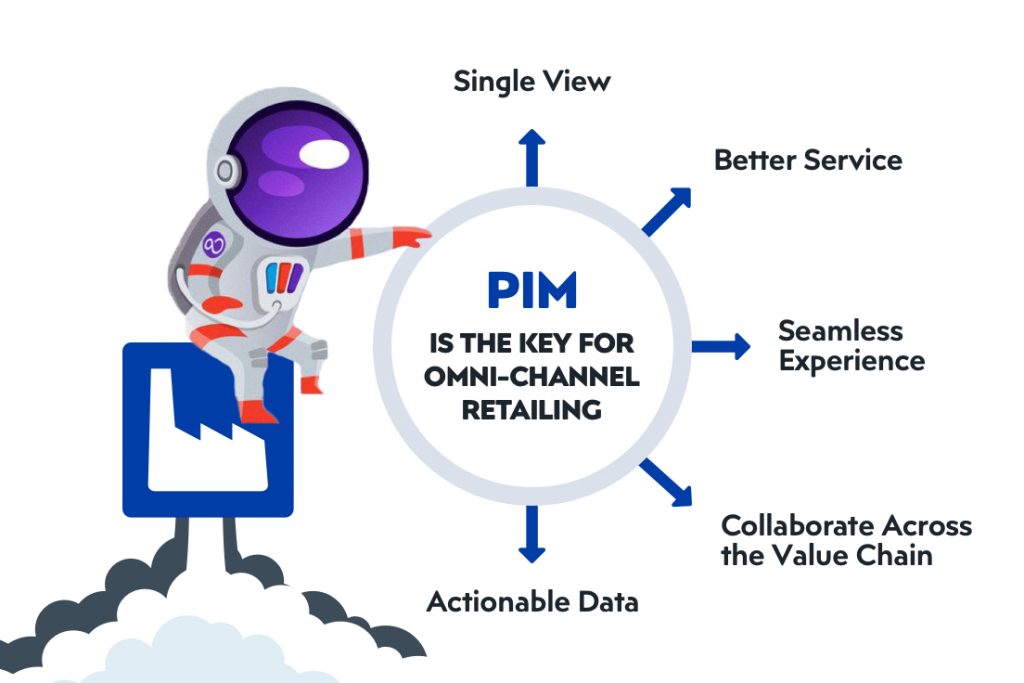
But what does that even mean? In short, that means that you must be everywhere! You should serve your customers with the same experience, no matter which channel they choose to use.
Even though you may not have the same audience on every channel, you must provide a consistent brand experience. Customers must be able to recognize your brand whenever and wherever they see it.
Thousands of companies have already adopted this business strategy and it’s working for them! Just take Apple as an example. They’re an ideal omnichannel business.
Omnichannel is a very important initiative, so we decided to dedicate a whole chapter just for omnichannel!
And it’s coming up next!
Is omnichannel the future of retail?
Customers’ expectations are reaching new heights. Their priorities are changing rapidly. They want to have perfect shopping experience on every channel they’re using.
These changes are happening at such a rapid pace, that companies can no longer neglect the use of new technologies.
Now, if they’re looking to increase their revenue and improve their customer experience, they must be more agile and place their focus on the customer.
First of all, let’s define omnichannel.
Omnichannel is a cross-channel content strategy used to improve user experience, implying that communication channels are designed to cooperate. – Manny Medina, Max Altschuler, Mark Kosoglow
An omnichannel approach benefits the customer in three simple ways:
- Easy to find all the needed information to simplify the buying decision
- Constant personalized services across channels
- A more pleasant and convenient way to buy
Meanwhile, there are several benefits of omnichannel for businesses:
- Enhanced selling probability
- Improved customer experience
- Establishing trust between customers
- More upsell and cross-sell opportunities
Every day there are new technologies appearing in the market. Recently, we got a hold on voice command assistants, IoT devices, smartwatches and many more new devices. These devices are raising standards when it comes to customer experience.
We’re given a glance at the future of shopping.
Retailers are using these new technologies throughout their business. They’re using them to optimize their operations, reduce operating costs and manage their business processes.
Try to picture a next-generation store where displayed products have enough intelligence to show you all of the data you need. By that, we mean price changes in real-time, expiry dates, usage information, and much more.
The store is communicating with both customers and companies. It can even contact the vendors and suppliers regarding inventory requirements.
Additionally, all of the product information is constantly updated across all channels, including a mobile app, website, social media, POS, IoT device and more.

By now, you can already see why consistency of product information is essential. If a customer finds any disparity across channels, that can negatively impact their customer experience!
Let’s say you’re a shoe retailer. The customer just bought a new pair of shoes only because of the unique waterproof feature. A few hours later, the same customer browses through your mobile app and sees the exact same pair of shoes. But it doesn’t say that they’re waterproof.
This particular situation leads to customer dissatisfaction. It directly affects customers’ future purchasing decisions. And if you’re that shoe retailer – it’s not looking good for you.
But you can change that!
Your every activity and brand message needs to be consistent across all of your communication channels.
Huge retailers are proactively creating immersive customer experiences by combining new technologies.
You can do that too. We made a detailed article on omnichannel, its trends and ways of implementing it so feel free to check it out. It may help you with making crucial decisions about your new approach towards the customers.
There is no omnichannel without PIM!
Product information management is an essential tool when it comes to setting up your omnichannel strategy.
It gathers all of your technical, usage, and emotional product information in one central place, making it easy to distribute to any of your communication channels.
As customers’ priorities are changing rapidly, it’s important to rely on data and make data-driven decisions.
Rebecca Minkoff, a global fashion brand, did a brilliant job implementing an omnichannel strategy in their retail business!
As you can see in the video, they massively increased their sales in a short period of time – less than a year! When you implement PIM, you as a retailer will benefit in several ways:
Single view – Get a consolidated view about the available asset information across the organization, regardless of which channels are accessed.
Better service – Give retailers the ability to engage and respond to customer inquiries promptly through various channels
Seamless experience – Make it easy to align with customer experiences and allow retailers to cater to varying demands.
Collaborate across the value chain – Offer a flexible and extendable syndication capability enabling retailers to make product data available to channel partners and marketplaces.
Actionable data – Consistently gather critical information and service data about customers for deeper insight into the customer journey for higher customer satisfaction and loyalty.
PIM is perfect for any company handling a huge amount of data.
Nevertheless, trends are changing constantly and PIM is no exception.
In the next chapter, find out how product information management trends are evolving and what your next step should be.
Trends in product information management
First of all, PIM is one of the markets in transition. It’s breaking out of its operational roots and playing a much bigger role in higher enterprise priorities like driving customer experience.
Of course, things like managing accurate product data and having a single source of truth still matter. But there are more and more PIM users leveraging that product data to create more compelling customer experiences.
Using machine learning for product recommendations or even 3D product renderings as a means of creating more compelling product content.
Secondly, because there is now more integration between PIM and customer experience objectives, there has been a level-up to more of an enterprise-level of priority. Meaning that there is a whole new set of potential users PIM is applicable for.
As soon as companies adopt basic principles of PIM, their attention shifts to optimization. They pay closer attention to data quality. PIM vendors respond to these needs by providing more advanced features and functionalities.
Some vendors offer more template-based solutions for quicker implementation, but their open-source solutions are becoming more and more important – due to the better customization needs. An example of such an open-source PIM solution is Pimcore.
Additionally, there are some more trends lately in the PIM industry:
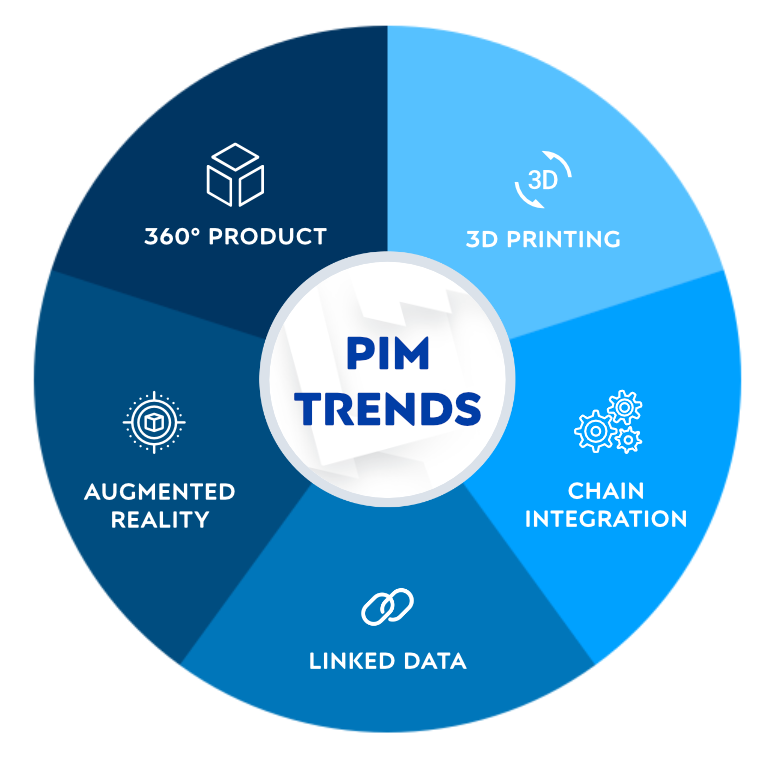
These trends are going to win over the PIM industry so consider including them in your future content strategies:
- 360° product – besides 360° customer view, the need for 360° product images is rising, having customer feedback and social data elements incorporated.
- 3D printing – when it comes to 3D printing, it requires more product information than usual. It’s required to manage the design, description and any kind of personalization to be able to print 3D objects.
- Chain integration – suppliers interested in your products show all the right content on the web. They are putting more attention to feeding rich content in data pools.
- Linked data – by using linked data, you can create websites which are more easily found by search engines. The development of a linked data-language can essentially lead to virtual PIM systems.
- Augmented reality – data within PIM is used to an AR-based interface on websites. Thanks to AR, users visiting product pages can interact with products with the help of their smartphones. L’oreal, Wayfair and Audi are already using PIM to leverage AR potential.
- Intelligent PIM (Generative AI and ML Integration) - Artificial intelligence and Machine learning in PIM systems can automate data categorization, enrichment, and recommendation. AI-powered PIM can also aid with translations, guaranteeing consistent product information across global markets and reducing manual efforts. Read more about the potential of integrating Generative AI with PIM.
All in all, PIM is greatly influenced by emerging technologies and many users are using that in their own favour. Try to keep up with the newest trends and your PIM strategy may prove extremely solid!
Best practices of product information management
Despite the growing importance of strategic management of product information, many are still unfamiliar with the processes of implementing a strategy.
Here are listed some of the most important practices:
Unify all product information
To establish proper infrastructure for managing product information, you need to gather all of your data in a single point. If you do that, your team members can now easily access the information and distribute it across all of your communication channels.
Additionally, it’s essential to determine how you will format that information and to abide by these standards.
That way, errors in product information are minimized and your control over product management is improved.
Create efficient processes
Launching a new product or updating an existing one can prove to be a time-consuming process. By creating workflows and processes and by using a PIM system to speed up those operations – you are decreasing the amount of time spent managing product information and shorten time to market.
Product information management systems, such as Pimcore, usually come with an advanced workflow engine. It can create the most complex workflow scenarios. Meaning, it’s able to adapt to companies of any size and complexity.
Implementing these efficient processes comes along with the improvement of team collaboration. Workflows guide team members in their tasks and processes, notifying them about other team members’ contributions and progress.
By creating efficient processes, you can now bring new products to market faster, save your time on managing product information and increase revenue.
Enrich product information
If used correctly, product information can be a huge competitive advantage for retailers.
Somewhat obvious steps of improving the quality of your product information are creating unique, converting product descriptions and adding high-resolution product videos and images.
These critical pieces are sometimes overlooked. Managing product information may be in vain if the information you’re providing doesn’t satisfy your customer. Try to create a clear picture of what your product is by using clean copy and high definition imagery.
Optimize your product information
Product information management is a key element in optimizing the performance of your products.
In the end, there are two things you need to have a successful eCommerce store – attracting quality traffic and converting visitors into customers. For you to do that, try to focus on the following:
- Create unique, converting and SEO optimized product information
- Consider A/B testing to find out which version of your product information is most successful
- Adapt your product information to different sales channels and market segments so you can increase your conversion rates
- Analyze the performance of your products and constantly optimize your product information to increase conversion rates
By following these simple steps, you can improve your efficiency and increase revenue. This is a long-term game so you should consider mapping out your strategy to make your goals clear.
But still, it may be unclear on how to use a PIM?
We’ll make it clear in the next chapter.
How to use a product information management system
In this chapter, we’ll show you how to use a PIM system.
We’re going to use Pimcore’s PIM system to show you some basic functionalities inside the system itself. Pimcore team did an awesome job and created this super-helpful video about their system.
When you start, you’ll see something like this.
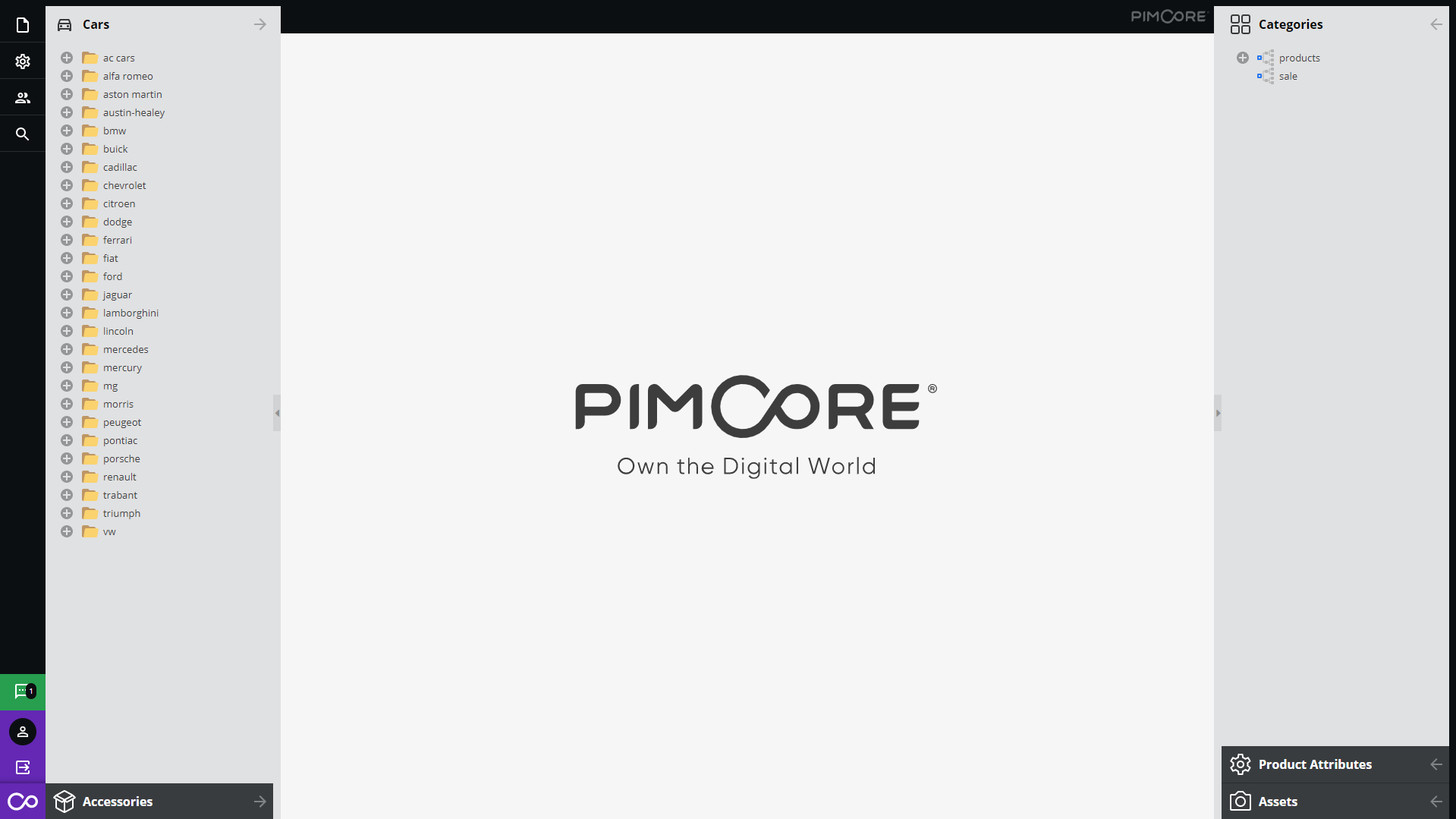
On the left side, we have listed car brands. Plus the additional functionalities besides PIM itself, as it integrates with other Pimcore products.
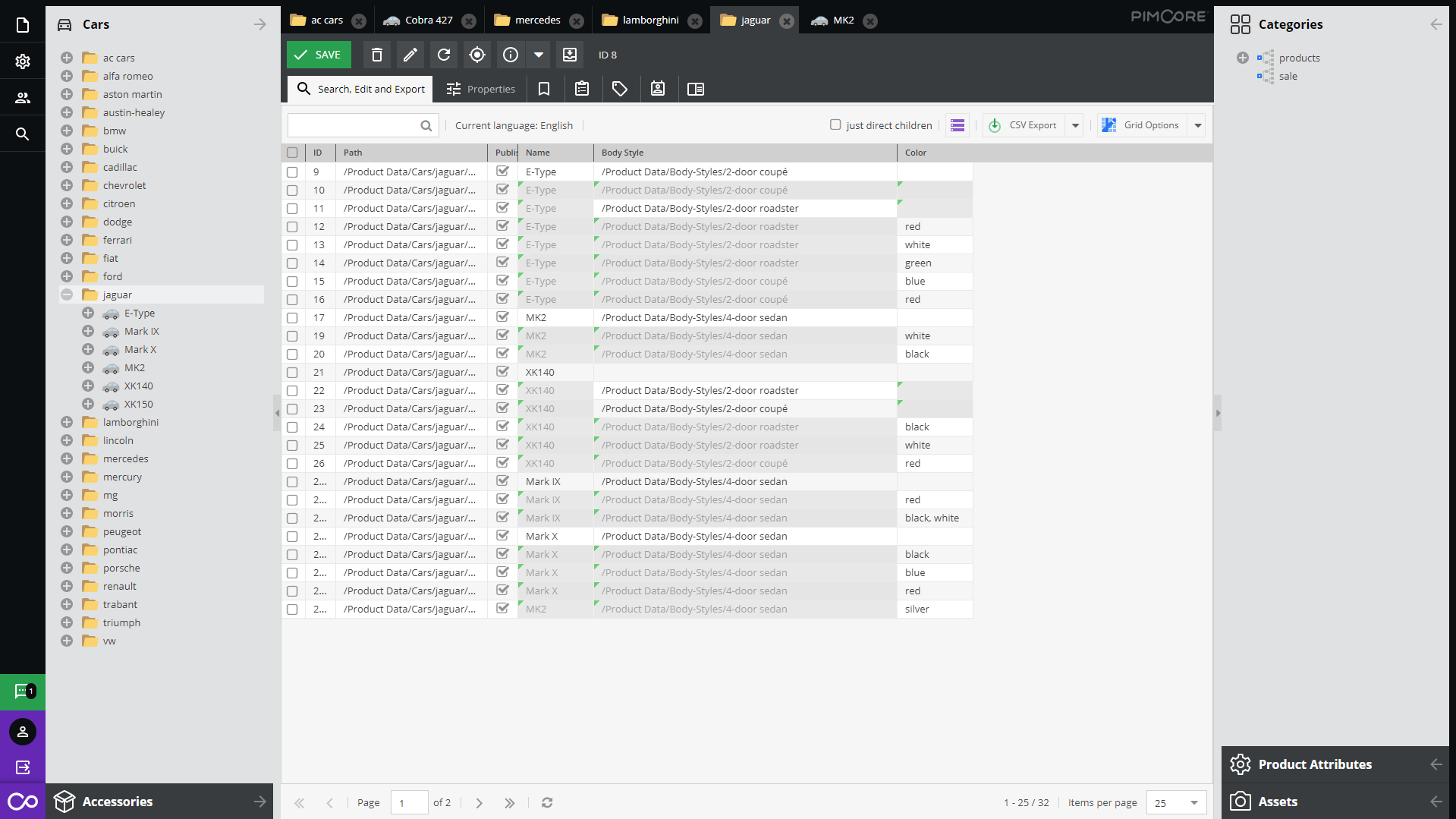
When selecting a certain car brand, you can filter them by model. As you can see, each model comes in several different colors. Such control over hierarchy makes it easy to use, even with hundreds of products.
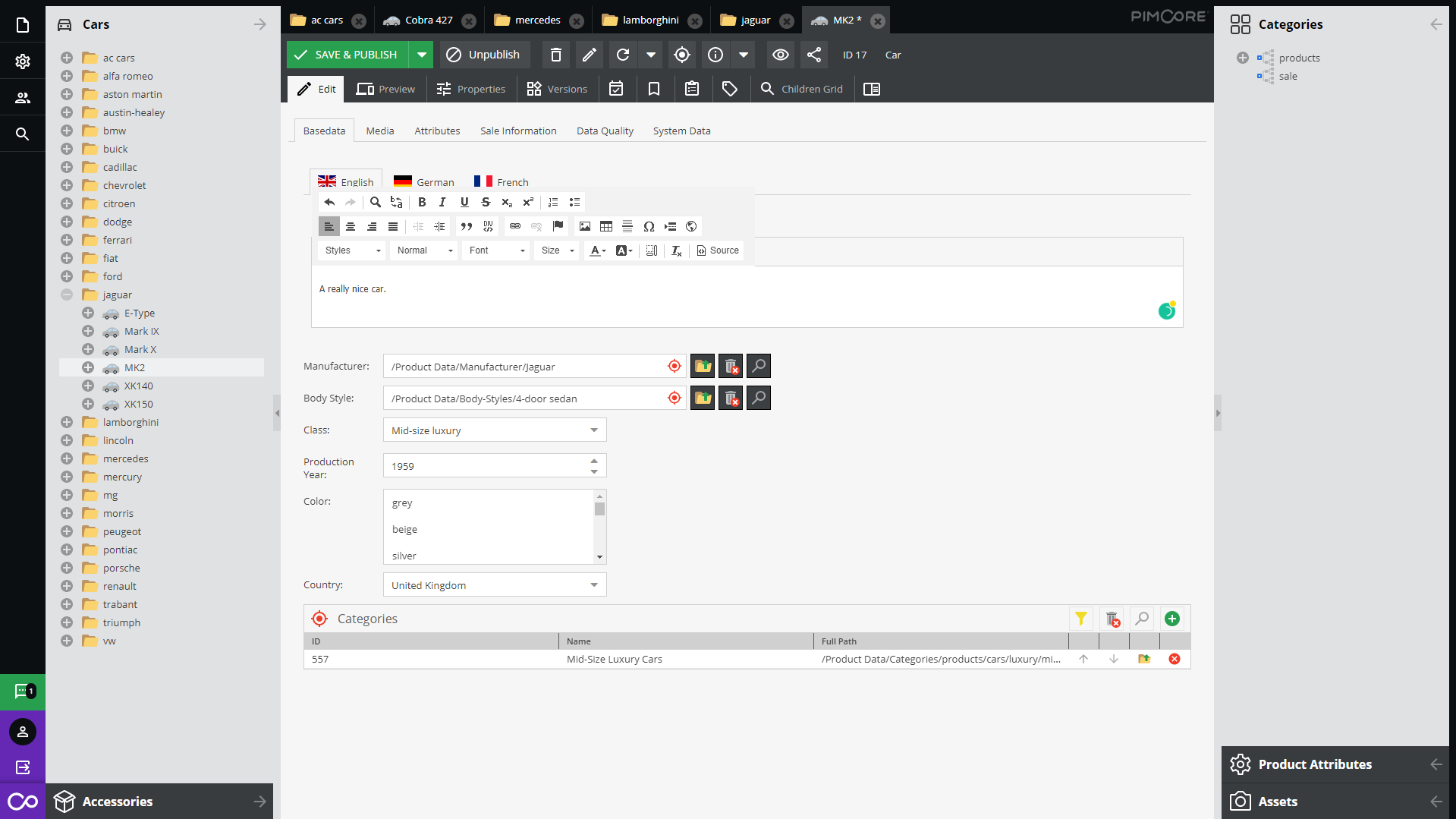
By choosing one specific product, such as a car in this example. You can change any of its attributes. Pimcore’s dashboard automatically offers you to change product description in several languages, as seen on the image.
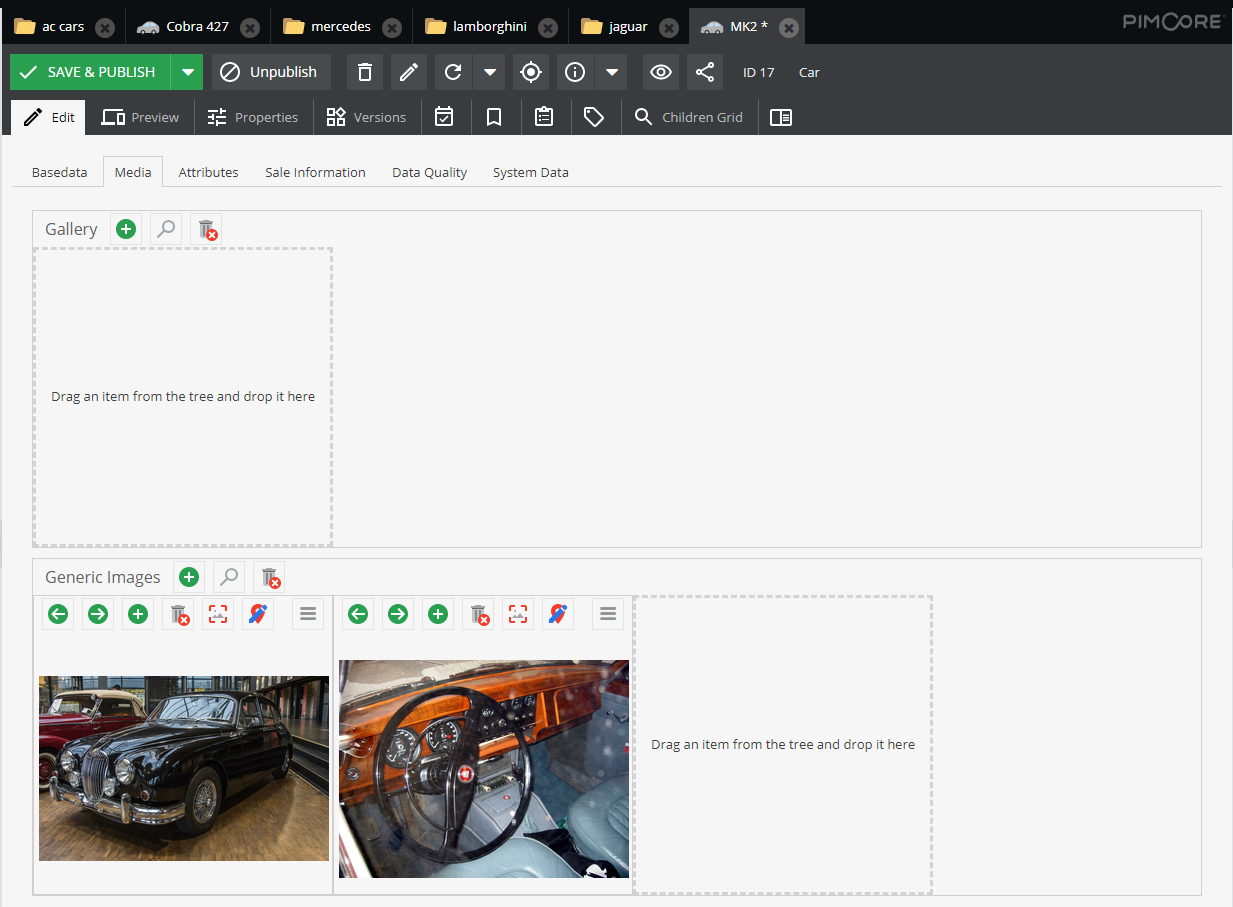
Any media file, such as images and videos, are added by a simple drag-and-drop action. You can additionally edit each file, according to your needs – crop it, add a marker or designate a certain area of the media file.
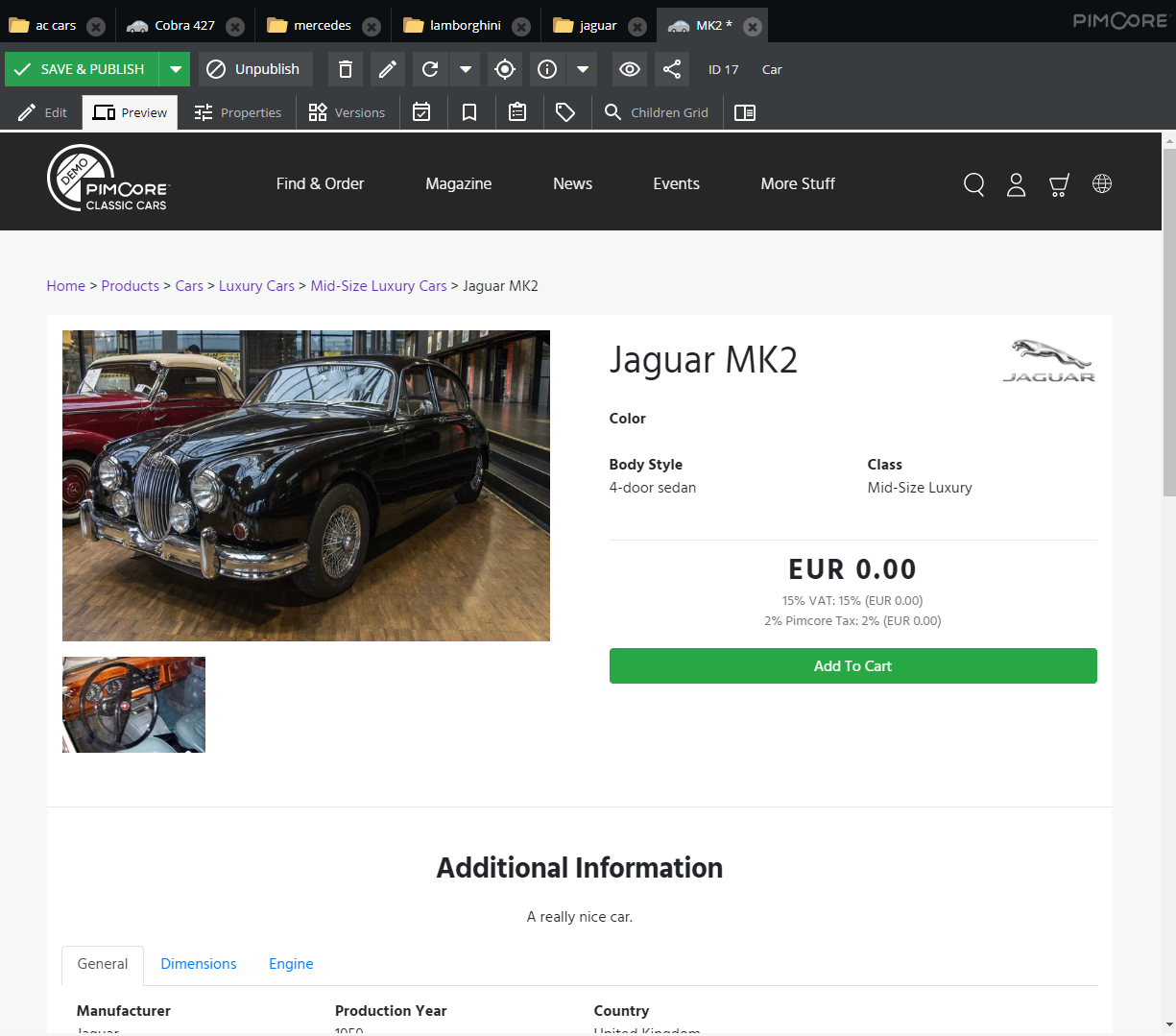
And when everything is assembled, the preview of your website will look something like this one. If you’d like to see what else can you do with your product information – check it out for yourself!
Every product has its own assets, media files, text descriptions and attributes. The data hierarchy in Pimcore allows you to asses every single piece of your product information – in an instant!
What is the best product information management system?
Well, it’s hard to say which one is the best.
It all depends on your business needs. If you’re a business owner, managing huge amounts of product data and still using spreadsheets – our best recommendation is Pimcore.
In one of our articles, we’ve compared Pimcore vs. Akeneo – 2 major PIM systems on the market. Check out which one suits you the best!
Luckily, we’re proficient in building product information management solutions and we’d be happy to help you with your PIMt system.
Pimcore is a platform which can conform to your every need, be it in data management or experience management. We have found Pimcore’s PIM to be an all-round high-quality system and by now – the results can confirm that!
We have made success possible for over 150 clients and if you’re ready – we would gladly help you write your own success story.
Contact us and let’s talk about your ideas!






